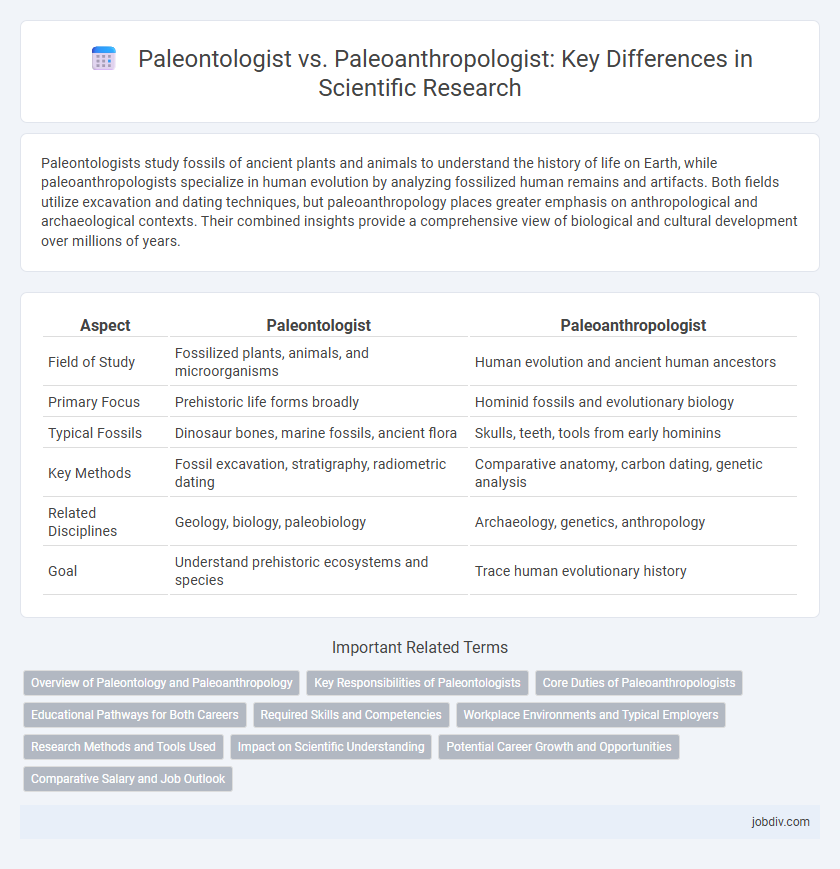Paleontologists study fossils of ancient plants and animals to understand the history of life on Earth, while paleoanthropologists specialize in human evolution by analyzing fossilized human remains and artifacts. Both fields utilize excavation and dating techniques, but paleoanthropology places greater emphasis on anthropological and archaeological contexts. Their combined insights provide a comprehensive view of biological and cultural development over millions of years.
Table of Comparison
| Aspect | Paleontologist | Paleoanthropologist |
|---|---|---|
| Field of Study | Fossilized plants, animals, and microorganisms | Human evolution and ancient human ancestors |
| Primary Focus | Prehistoric life forms broadly | Hominid fossils and evolutionary biology |
| Typical Fossils | Dinosaur bones, marine fossils, ancient flora | Skulls, teeth, tools from early hominins |
| Key Methods | Fossil excavation, stratigraphy, radiometric dating | Comparative anatomy, carbon dating, genetic analysis |
| Related Disciplines | Geology, biology, paleobiology | Archaeology, genetics, anthropology |
| Goal | Understand prehistoric ecosystems and species | Trace human evolutionary history |
Overview of Paleontology and Paleoanthropology
Paleontology studies fossils and ancient life forms to understand Earth's biological history, analyzing organisms from millions of years ago. Paleoanthropology, a subfield of paleontology, concentrates on the evolution and biology of early humans and their ancestors through fossil remains and artifacts. Both disciplines employ stratigraphy, radiometric dating, and comparative anatomy to reconstruct past environments and evolutionary processes.
Key Responsibilities of Paleontologists
Paleontologists specialize in studying fossils to understand the history of life on Earth, focusing on the identification, classification, and analysis of ancient organisms' remains. They conduct field excavations, prepare specimens for examination, and use radiometric dating and comparative anatomy to reconstruct prehistoric environments. Their key responsibilities include interpreting fossil evidence to trace evolutionary processes and contributing to knowledge of biodiversity changes over geological time.
Core Duties of Paleoanthropologists
Paleoanthropologists specialize in studying ancient human ancestors through fossilized remains, focusing on understanding human evolution, behavior, and morphology. Their core duties include analyzing hominin fossils, reconstructing evolutionary timelines, and interpreting archaeological evidence related to early humans. They often collaborate with archaeologists and geneticists to provide comprehensive insights into human origins and prehistoric environments.
Educational Pathways for Both Careers
Paleontologists typically pursue a bachelor's degree in geology or biology, followed by a master's or PhD specializing in fossil studies and Earth's prehistoric life. Paleoanthropologists usually study anthropology or archaeology at the undergraduate level, advancing to graduate programs focused on human evolution and ancient hominid fossils. Both fields require extensive fieldwork experience and research, but paleoanthropology emphasizes human lineage and cultural development while paleontology covers a broader range of extinct organisms.
Required Skills and Competencies
Paleontologists require strong skills in fossil identification, geological analysis, and proficiency with field excavation techniques to study ancient life forms and environments. Paleoanthropologists must excel in anthropological theory, skeletal morphology, and advanced dating methods to interpret human evolution from fossil records. Both fields demand critical thinking, precise data recording, and expertise in laboratory analysis to reconstruct past biological and cultural developments.
Workplace Environments and Typical Employers
Paleontologists predominantly work in universities, natural history museums, and geological survey organizations where they study fossils and ancient life forms. Paleoanthropologists are typically employed by research institutions, universities, and museums specializing in human evolution, focusing on ancient human ancestors and their habitats. Both professions often conduct fieldwork at excavation sites, but paleoanthropologists frequently collaborate with anthropologists and archaeologists in interdisciplinary environments.
Research Methods and Tools Used
Paleontologists utilize techniques like stratigraphic analysis, radiometric dating, and fossil excavation tools to study ancient life forms and ecosystems across geological time. Paleoanthropologists employ methods such as cranial morphometrics, comparative anatomy, and advanced imaging technologies like CT scanning to analyze hominin fossils and evolutionary traits. Both disciplines rely on laboratory techniques like isotopic analysis and 3D reconstruction to interpret fossil data and evolutionary patterns.
Impact on Scientific Understanding
Paleontologists primarily study fossils of ancient plants and animals, providing critical insights into Earth's biological history and evolutionary processes. Paleoanthropologists focus specifically on fossil evidence related to human ancestors, deepening scientific understanding of human evolution, behavior, and migration patterns. Together, their research shapes comprehensive knowledge of life's development and humanity's place within the natural world.
Potential Career Growth and Opportunities
Paleontologists and paleoanthropologists both offer promising career growth driven by expanding research in prehistoric life and human evolution. The global demand for expertise in fossil analysis and evolutionary biology fuels opportunities in academia, museums, and environmental consulting. Specialized skills in advanced dating techniques and genetic analysis further enhance career prospects in these interdisciplinary fields.
Comparative Salary and Job Outlook
Paleontologists specializing in fossilized animals typically earn median salaries ranging from $70,000 to $100,000 annually, reflecting demand in academic and museum research sectors. Paleoanthropologists, focused on human evolutionary studies, often have slightly higher median salaries between $75,000 and $110,000, driven by positions in universities and cultural heritage projects. Job outlook for both fields indicates moderate growth, with paleoanthropology expected to benefit from increased funding in human origins research, while paleontology sees steady prospects linked to environmental and geological studies.
Paleontologist vs Paleoanthropologist Infographic

 jobdiv.com
jobdiv.com